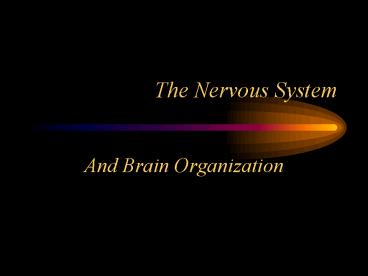The Nervous System - PowerPoint PPT Presentation
1 / 20
Title:
The Nervous System
Description:
The Nervous System And Brain Organization Central Nervous System Consists of the brain and spinal cord The brain is the central computer of the nervous system ... – PowerPoint PPT presentation
Number of Views:71
Avg rating:3.0/5.0
Title: The Nervous System
1
The Nervous System
- And Brain Organization
2
Central Nervous System
- Consists of the brain and spinal cord
- The brain is the central computer of the
nervous system - The spinal cord is the cable that is used to
communicate to the rest of the body
3
Peripheral Nervous System
- All the parts of the nervous system outside of
the brain and spinal cord - Two major divisions
- Somatic system the muscles and sense organs
(voluntary behavior) - Autonomic system the internal organs and glands
(involuntary behavior)
4
Autonomic Nervous System
- Two divisions
- Sympathetic branch arouses the body
- Prepares the body for fight or flight
- Parasympathetic branch quiets the body or
brings it back to normal
5
Nervous System
Central Nervous System
Peripheral Nervous System
Brain
Spinal Cord
Autonomic System
Somatic System
Sympathetic System
Parasympathetic System
6
Brain Organization
- Cerebrum two large hemispheres that cover the
upper part of the brain - Cerebral cortex the outer layer of the cerebrum
- made up of wrinkled gray matter that contains
nerve cell bodies
7
Brain Organization contd
- Cerebral hemispheres right and left halves of
the cerebrum - Corpus callosum bundle of fibers connecting the
hemispheres - Cut in a split-brain operation
- Spatial neglect when a person pays no attention
to the left side of visual space after damage to
the right hemisphere
8
Lobes of the Cerebral Cortex
- Lobes areas on the cortex defined by major
fissures or functions - Occipital lobe vision
- Parietal lobe bodily sensations (touch,
temperature, pressure)
9
Lobes of the Cerebral Cortex
- Temporal lobes language (on the left only) and
hearing - Frontal lobes motor control, speech, abstract
thought - Association cortex all areas of the cerebral
cortex not primarily sensory or motor in function
complex skills like language, memory,
recognition, and problem solving
10
Parietal lobe
Frontal lobe
Occipital lobe
Temporal lobe
Cerebellum
11
Association Cortex
- Brocas area language area grammar and
pronunciation left frontal lobe - Aphasia speech disturbance related to brain
damage - Wernickes area language comprehension left
temporal lobe - Agnosia inability to identify seen objects
12
(No Transcript)
13
Subcortex
- Subcortex - all brain structures below the
cerebral hemispheres - Divided into three parts
- Brainstem (or hindbrain)
- Midbrain
- Forebrain
14
The Brainstem
- Also known as the hindbrain
- Lowest portions of the brain
- Contains the cerebellum, medulla and pons
15
- Cerebellum controls posture, muscle tone and
coordination stores memories related to skills
and habits - Medulla connects brain to spinal cord
controls vital life functions such as heart rate,
breathing, swallowing, etc. - Pons bridge between medulla and other
structures influences sleep and arousal
16
The Midbrain
- Small region, located above spinal cord, but
below the forebrain - Coordinates simple muscle movements with sensory
information - Reticular formation network of fibers and cell
bodies throughout the hindbrain associated with
attention, alertness and some reflexes
17
The Forebrain
- Contains the thalamus and hypothalamus
- Thalamus located on top of brain stem relays
sensory information to the cerebral cortex - Hypothalamus controls metabolic functions
including body temp, libido, hunger, thirst, and
the endocrine system
18
(No Transcript)
19
The Limbic System
- Contains hypothalamus, parts of the thalamus,
amygdala, and hippocampus - Large role in producing emotion and motivated
behavior - Amygdala associated with fear responses
- Hippocampus associated with storing memories
(lies in the temporal lobe)
20
(No Transcript)

